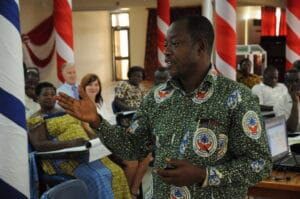Today, Ghana has a relatively strong credit union system that serves the needs of the people and their communities; however, this was not always the case. In fact, the credit union system looked very different in the early 1980’s and was on the brink of collapse. But with the dedication and expertise of international partners – like CDF Canada and the World Council of Credit Unions – and the willingness of the Ghanaian people, the system was revived.
A Look into the Past
The demise of the Ghana Credit Union system began after the Konrad Adeneaur Foundation (KAF) – the major funding partner of the Credit Union of Africa (CUA) – withdrew its support in 1983, leaving over 500 credit unions to fend for themselves. Without KAF support, the situation on the ground, between 1983-1994, quickly deteriorated:
 The image of CUA and the credit unions became tarnished and their credibility as high-functioning financial institutions. Thankfully, in 1994, the World Council of Credit Unions (WCCU, which succeeded CUNA International as the global federation for all credit unions after) and ACCOSCA (a Pan-African confederation of national associations of savings and credit cooperatives societies) stepped in. They introduced the African Revitalization Program to encourage credit unions in Africa to evolve from their predominantly social orientation to one that takes a more business-minded approach in their operations; to ensure the survival of the credit union system in Africa. As a result,Ghana was one of the seven countries selected for the pilot program, which received financing and technical support from the world council.
The image of CUA and the credit unions became tarnished and their credibility as high-functioning financial institutions. Thankfully, in 1994, the World Council of Credit Unions (WCCU, which succeeded CUNA International as the global federation for all credit unions after) and ACCOSCA (a Pan-African confederation of national associations of savings and credit cooperatives societies) stepped in. They introduced the African Revitalization Program to encourage credit unions in Africa to evolve from their predominantly social orientation to one that takes a more business-minded approach in their operations; to ensure the survival of the credit union system in Africa. As a result,Ghana was one of the seven countries selected for the pilot program, which received financing and technical support from the world council.
A Flourishing Partnership
In 1993-94 a national study was conducted by the ACCOSCA and WCCU, which indicated that despite the setbacks and deterioration of the system, there was still significant potential for credit union development in Ghana.
The report also caught the attention of the Canadian International Development Agency (CIDA) and the Canadian Cooperative Association (CCA). At that time, CCA was already working with CUA (since 1987) as part of the Women in Development Program – the aim was to improve access to financial services by women and enhance their role as societal leaders With challenges facing the Ghanaian system and the huge potential for development, an ambitious project – coined the Ghana Credit Union Development Assistance Program (GCUDAP) – was born.
The revival would require collaboration by many organizations with a shared interest in strengthening the credit union movement. In true cooperative spirit, a partnership between the CCA, CUA, CIDA, the Department of Co-operatives (DOC), Bank of Ghana (BOG) and the Ministry of Employment and Social Welfare emerged, to develop a six-year project that would significantly increase the capacity and effectiveness of the credit union system in Ghana.

Cashier and loans officer at Zabzugu Kworli Credit Union, Northern Ghana.
Project Goals
The primary goals of the project were to increase the financial and operational viability of the Ghanaian credit unions, enhance female participation and integration into the network, use the system to increase the interaction between the formal and informal sectors of the economy, and ultimately transform, the CUA into an efficient, effective and self-sustaining national apex body. The six-year project commenced in 1995, marking the turning point of credit union development in the country, and the success of the Ghana Credit Union Development Assistance Project (GCUDAP), which achieved all its targets.
Project Challenges
The credit union system was riddled with the issues of high loan delinquency rates, liquidity, inadequate accounting records, and poor governance. And to make matters worse, at the national level, the image of the credit union movement and CUA itself was unpopular. Over the project period CUA and CCA worked tirelessly to achieve their goals, through extensive training programs for staff, management, and board members; the development of new policies, plans, and programs, alongside necessary staff restructuring, promotions and new positions.
Old and New Models
The key to the new direction for CUA was the adoption and promotion of the ‘New Model’ of Credit Union Development, as guided by the consensus reached ACCOSCA. The traditional ‘old model’ of credit unions in the country was closer to a social organization, usually volunteer-operated and operating out of whatever space was available. In contrast, the new model sought to make credit unions more professional and business-minded. Under this new model, CUs would be required to operate on professional management principles, adopt modern accounting practices, have at least some paid staff, and establish a proper office space. What remained steadfast throughout this evolution was the commitment to cooperative principles. A strategic balance of core credit union values and modern business principles and practices was necessary for the institutions to become more competitive and sustainable, ultimately better serving the needs of more members through the new approach.
Training was Key
Large-scale training played a key role in the willingness and adaption of the new approach amongst Ghanaian society, which was run out of the Bunsu Cocoa College. From October to November 1998, 60 existing and new managers from across Ghana were selected for placement at the college, where they would participate in intensive training on employing the principles of the new model and best practices for maximizing the effectiveness of credit unions operations.
The cost of the training program was significant but ultimately proved worth it, by producing some of the system’s best managers in the system, alongside best practices, which form the foundation of the modern credit unions in Ghana you see today.

CUA General Manager Emmanuel Darko addresses CCA’s governance coaching and mentorship workshop at CUA’s new training center.
Achievements of the Northern Revitalization Program
Another Ghanaian success story under the GCUDAP, is the Northern Revitalization Program, covering three of the country’s northern regions. The Program was designed to restore these credit unions to their former glory, after the economic hardships of the 1980’s forced many of them into near closure, with virtually no staff and operating at roughly 5% capacity. As part of the new business model pilot, over 150 managers and staff received training to upgrade their skills. Although not all northern credit unions were revived, there was considerable success, particularly in the upper west and northern regions, where savings and loans increased between 143% and 177%, and shares in the credit unions went up a whopping 2,671%, between 1999-2001.
Throughout the country, the GCUDAP was creating significant prosperity. In only two years, overall national growth was up 75%, savings up 87%, and shares up by 92%. The highly ambitious goal to increase savings from 4.8 billion Cedis to 14.6 billion by the end of the six-year project was not only met, but exceeded, with approximately 18,000 new members joining the credit union network. This growth also enabled CUA to expand its services, making them available to the nation’s institutions with much more efficiency.
CUA Partnerships Today
We are pleased to say the shared vision and collaboration between the CCA and CUA did not end with the GCUDAP, but is well alive through many smaller projects supporting gender, health, capacity building, and economic development. CCA and CUA also operate many exchange programs between Ghana and Canada, with two Canadian Interns coming to work at the CUA head office in Accra, every year. They also run an annual Coaching Program, where experienced Canadian experienced credit union managers or senior staff visit Ghana for two to three weeks, paired with local staff for capacity building through the sharing of experience and knowledge. And of course, the internationally known Women’s Mentorship Program, run by CDF Canada. In operations for over 12-years, this Program focuses on bringing female leaders from Africa to Canada, where they are placed with local credit unions here, for a four-weeks of intensive training. As a result, the women return to their own countries as better leaders, with increased confidence and new skills, ready to maximize the effectiveness of their local credit union operations.
Other international partnerships was also initiated, starting with the Irish League of Credit Unions (ILCUF) in 2007. The ILCUF provides funding through CCA, supporting the coaching, women’s mentorship, and other CUA development programs. This was followed by another partnership with the German Banking Foundation, in support of the Credit Unions Training Center (CUTraC) at Kasoa. Since 2010 CUA, has operated a very successful partnership with the GIZ (the German International Cooperation), providing resources, materials and five technical advisors (three at the head office in Accra and one in each of the western and northern chapters. Domestically, CUA is part of the Ghana Microfinance Network (GHAMFIN), and benefits from the occasional grants to support small capital projects.